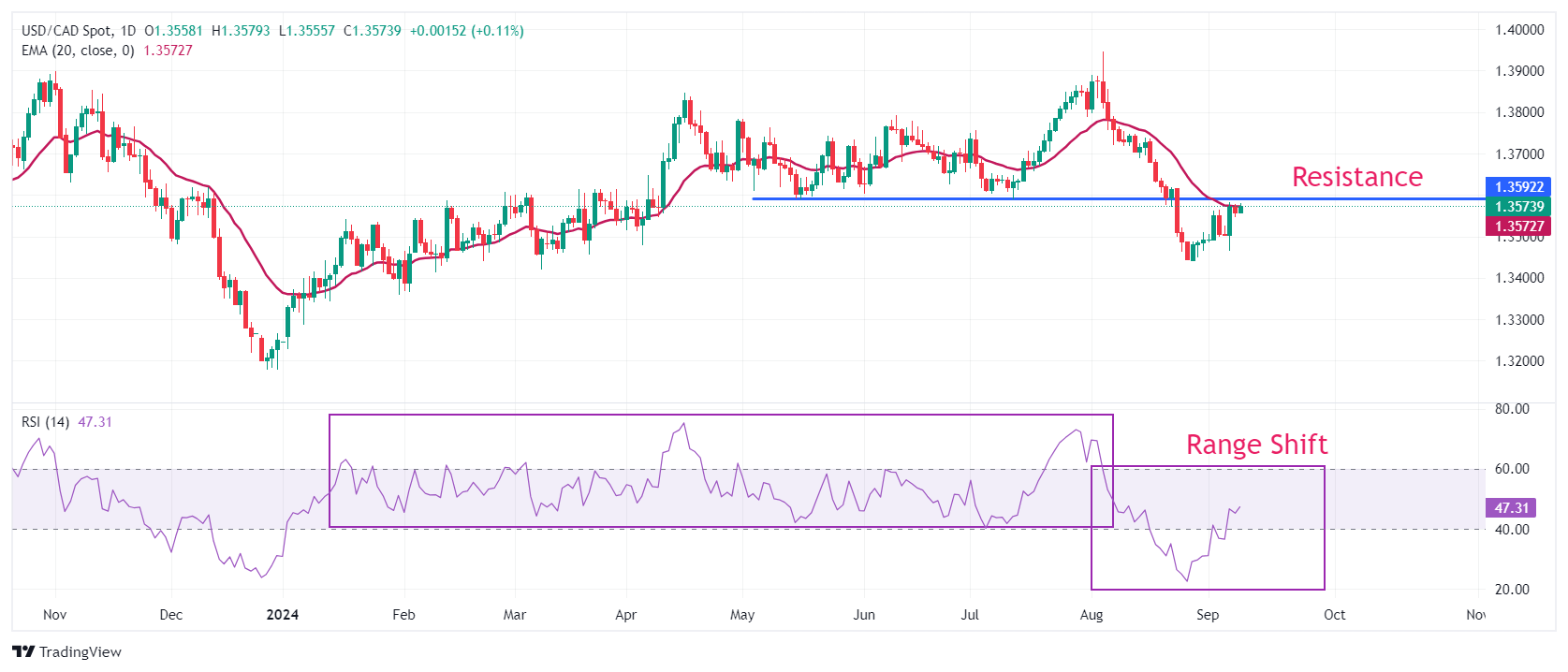USD/CAD Price Forecast: Clings to gains above 1.3550 ahead of US inflation, Presidential debate
- USD/CAD remains firm above 1.3550 with US CPI, Presidential debate taking centre stage.
- Investors see the US annual headline CPI declining to 2.6%.
- USD/CAD delivers a mean-reversion move to near 20-day EMA.
The USD/CAD pair holds into gains near 1.3550 in Tuesday’s North American session. The Loonie asset remains firm as the US Dollar (USD) clings to gains amid uncertainty ahead of the United States (US) presidential debate and the Consumer Price Index (CPI) data for August, which will be published on Wednesday.
The US Dollar Index (DXY), which tracks the Greenback’s value against six major currencies, trades close to Monday’s high of 101.60.
Investors will keenly focus on presidential debate between current Vice President Kamala Harris and former US President Donald Trump over November elections. Signs of Trump gaining majority over Harris for winning elections could strengthen the US Dollar (USD) as he is known for favoring high fiscal spending and raising tarrifs.
The US annual headline CPI is estimated to have grown by 2.6%, slower than 2.9% in August, with core inflation rising steadily by 3.2%. The inflation data will significantly influence market speculation for Federal Reserve (Fed) interest rate cut path.
Meanwhile, the Canadian Dollar (CAD) remains under pressure as the Bank of Canada (BoC) is expected to cut interest rates further in the last quarter of the year.
USD/CAD delivers a pullback move to near the 20-day Exponential Moving Average (EMA), which trades around 1.3570. The near-term outlook of the pair appears to be bearish as the 14-day Relative Strength Index (RSI) has shifted into the bearish range of 20.00-60.00 from 40.00-80.00.
The horizontal resistance plotted from May 15 low of 1.3590 will be a major barricade for the US Dollar bulls.
A further pullback move to near the May 15 low of 1.3590 will likely be a selling opportunity for market participants, which would drag the asset towards the April 5 low of 1.3540, followed by the psychological support of 1.3500.
On the flip side, an upside recovery above August 21 high of 1.3626 would drive the asset towards 19 August high of 1.3687 and August 15 high of 1.3738.
USD/CAD daily chart

Canadian Dollar FAQs
The key factors driving the Canadian Dollar (CAD) are the level of interest rates set by the Bank of Canada (BoC), the price of Oil, Canada’s largest export, the health of its economy, inflation and the Trade Balance, which is the difference between the value of Canada’s exports versus its imports. Other factors include market sentiment – whether investors are taking on more risky assets (risk-on) or seeking safe-havens (risk-off) – with risk-on being CAD-positive. As its largest trading partner, the health of the US economy is also a key factor influencing the Canadian Dollar.
The Bank of Canada (BoC) has a significant influence on the Canadian Dollar by setting the level of interest rates that banks can lend to one another. This influences the level of interest rates for everyone. The main goal of the BoC is to maintain inflation at 1-3% by adjusting interest rates up or down. Relatively higher interest rates tend to be positive for the CAD. The Bank of Canada can also use quantitative easing and tightening to influence credit conditions, with the former CAD-negative and the latter CAD-positive.
The price of Oil is a key factor impacting the value of the Canadian Dollar. Petroleum is Canada’s biggest export, so Oil price tends to have an immediate impact on the CAD value. Generally, if Oil price rises CAD also goes up, as aggregate demand for the currency increases. The opposite is the case if the price of Oil falls. Higher Oil prices also tend to result in a greater likelihood of a positive Trade Balance, which is also supportive of the CAD.
While inflation had always traditionally been thought of as a negative factor for a currency since it lowers the value of money, the opposite has actually been the case in modern times with the relaxation of cross-border capital controls. Higher inflation tends to lead central banks to put up interest rates which attracts more capital inflows from global investors seeking a lucrative place to keep their money. This increases demand for the local currency, which in Canada’s case is the Canadian Dollar.
Macroeconomic data releases gauge the health of the economy and can have an impact on the Canadian Dollar. Indicators such as GDP, Manufacturing and Services PMIs, employment, and consumer sentiment surveys can all influence the direction of the CAD. A strong economy is good for the Canadian Dollar. Not only does it attract more foreign investment but it may encourage the Bank of Canada to put up interest rates, leading to a stronger currency. If economic data is weak, however, the CAD is likely to fall.

